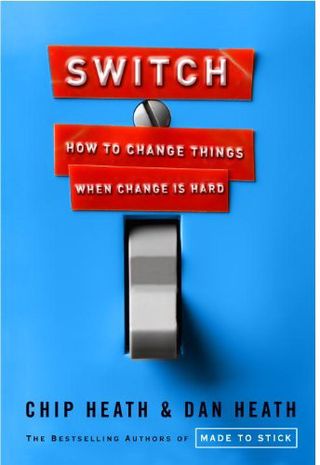How many times have you thrown up your hands, as a manager, parent, or business owner, and said "I give up.. I've tried everything and there is no way I can change this culture... or this pattern of behaviors?" We have all, at some point, hit major road blocks in our quest to find ways to implement lasting change.
As a practicing Clinical Psychologist, I could point you to a large library of books about how to create change, written in thickly worded scientific language...but rarely have I seen a book written in layman's language that breaks down the process and elements of change effectively.
I am nearing the end of a such a book. This well-constructed read by the Heath brothers is titled, "Switch: How To Change Things When Change Is Hard." It's one of those books I wish I had thought of writing (although I wouldn't have done nearly as good a job).
What they do, and do well, is manage to break down much of the information about the major elements of change, including how to create change, all presented in a concise book that's a joy to read. The brothers liberally borrow their basic analogy regarding the elements of change from Psychologist and researcher, Dr. Jonathan Haidt. The premise is that change involves two parts of the whole person that we are all familiar with -- A person's emotional side, as well as their rational side ("the brain").
And to create change you must impact both. The overpowering emotional side is identified as the "Elephant" and the rational, decision-making component sits atop the Elephant as the "Rider." When conflict arises between the two, the Rider is easily the underdog. Research tells us that in order to make lasting change, the Elephant and Rider need to unite.
The last element is "The Path," or a VERY clear direction.
Over the next three editions, I'll share with you examples of appropriate uses of the following options:
1. Directing the Rider - Analytical, Rational thinking
2. Motivating the Elephant - Appealing to Emotion and instinct
3. Shaping the Path - Providing clear Direction
1. Direct the Rider:
Finding the Bright Spots. In 1990, an international organization that helps needy children accepted a Vietnamese government invitation to decrease malnutrition. They were given only six months to make a difference. This short timeline made it impossible to end poverty, to purify water, or to build a sanitation system to address starvation. They had to find a simpler solution and find it fast. Most of us would waste precious time focusing on looking at, and even trying to magnify the problem. This organization didn't. Instead they traveled to a rural village and met with mothers whose children were thriving. They were obsessed with finding the "Bright Spots." Despite widespread malnutrition, they found them. They discovered that "bright spot" moms fed their children four times a day (easier on kids' digestive systems), vs. the standard two meals. Another finding was that bright spot moms added shrimp and crab from the rice paddies into their kids' meals. Cooking classes where bright spot moms taught other mothers how to prepare healthy meals for their children ensued. The mothers already had the emotional motivation (Elephant) in the form of their natural concern for their kids. They needed direction (The Rider needed a Path), not motivation. Six months later, 65 percent of the village kids were better nourished and stayed that way.
How often have you set out to find exactly what your best agents and managers do right...not just generally, but as specifically as possible? How do they organize their days? How many calls and emails do they make and to whom do they make them? Figure out the detailed formula utilized by the best of the best, and then deduce the common denominators.
Point to the Destination. In the mid 1980s, a major investment firm's research department ranked an embarrassing fifteenth among their banking clients. This coincided with the hiring of a new GM, labeled "The Company Coach." After discovering that the analysts of the company had become isolated from clients and each other, holding onto knowledge rather than sharing information and credit, he set the expectation for all analysts to initiate at least 125 client conversations per month. In addition, he required analysts to cite colleagues' work at least twice during presentations, thus promoting a team environment. He told everyone that he expected the firm to be among the premiere investment magazine's top five. He directed the rider by laying out clear expectations (make 125 calls and cite colleagues work), and he also painted the destination. In three years, the firm went from fifteenth to first place.
We have several clients who have done something similar to the above examples with regard to addressing goals around recruiting expectations. Is it possible for you to be even more enticing with a clearer, more compelling goal? Can you be precise about your exact expectations? Instead of saying, "Make more recruiting calls,"...say, "Make X number of calls and X number of appointments per week."
In the next edition, I'll discuss ideas around Motivating the Elephant.




Comments